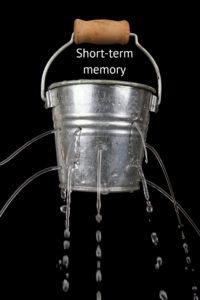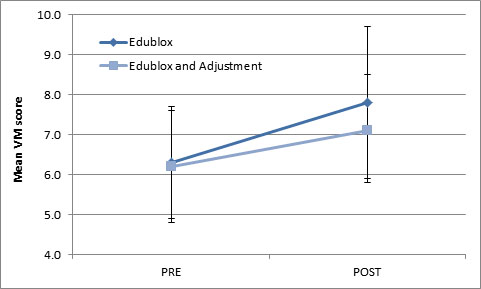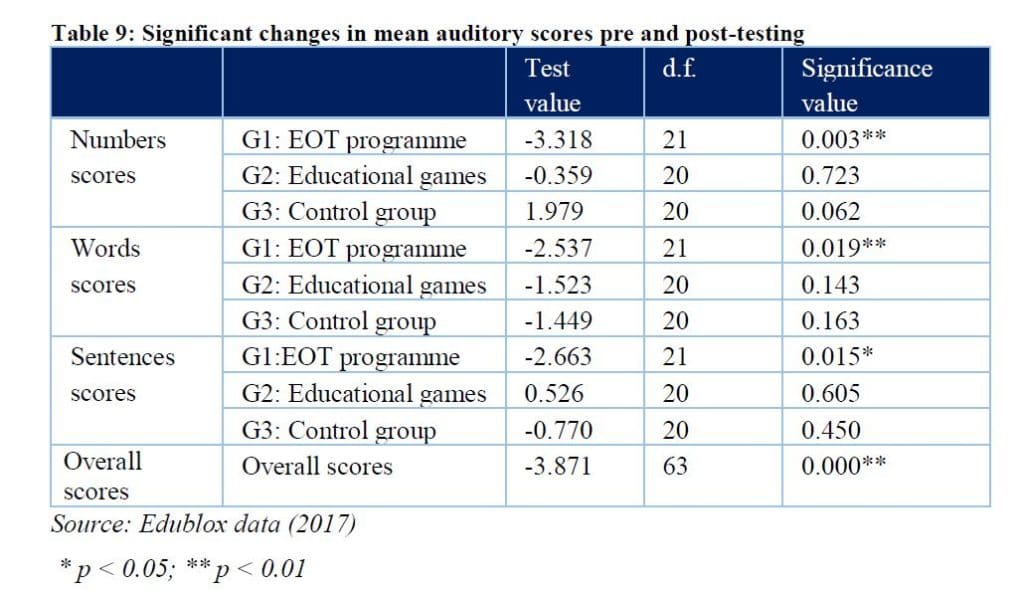
Short-term memory holds a small amount of information in the mind for a few seconds. Short-term memory is limited to about seven items and will be lost in about fifteen seconds unless the information is rehearsed.
If you have looked up a telephone number in a directory, you already know much about short-term memory. You repeat the number to yourself until you dial, and the number is forgotten by then. That’s short-term memory at work.
Table on contents:
- Capacity of short-term memory
- Duration of short-term memory
- Short-term vs. working memory
- Losing information from short-term memory
- Transfer to long-term memory
- Poor memory a barrier to learning success
- Test your short-term memory
- Program to improve short-term memory
Capacity of short-term memory
The amount of information that can be held in short-term memory is an intriguing question. Your own experience should tell you that short-term memory’s capacity is limited, perhaps to the amount of information in a seven-digit telephone number. Experiments that test a subject’s ability to recall a series of items usually report similar results.
These findings created quite a puzzle for psychologists because defining the abstract term “item” was difficult. People could remember seven numbers, seven proper names, seven letters, seven faces, seven Shakespearean verses, or seven proverbs. Clearly, the amount of information in each of these “items” is very different.
Cognitive psychologist George A. Miller addressed this problem in 1956 in a paper called “The Magical Number Seven, Plus or Minus Two.” He suggested that short-term memory could hold about seven chunks of information ± two. A chunk refers to anything represented in long-term memory as a single unit.
Short-term memory capacity can be dramatically increased by reorganizing information into larger chunks.
Duration of short-term memory
Besides a limited capacity, short-term memory also has a limited ability to hold items for any length of time. In one classic experiment, subjects tried to remember three alphabet letters. After eighteen seconds, they could not remember the letters. These people were not slow-witted; they were simply not allowed to rehearse because they were counting backward by threes during those eighteen seconds. Unless the chunks in short-term memory are rehearsed, they are quickly forgotten.
These limitations on short-term memory are very puzzling, considering how much work it must do. For example, with a short-term memory that can only hold seven items at a time, how can we read so quickly and comprehend what we are reading?
The answer lies in the idea that short-term memory is not just a passive storehouse for a limited amount of information. It is a dynamic information processor that performs computations, screens information, and interacts constantly with long-term memory. Many psychologists prefer to call short-term memory “working memory” to emphasize its information-processing role. To show how this might work and how short-term memory must interact with long-term memory, read the sentence below once. Then, look up and try to recall the sentence.
.
“In the failing days of the Roman Empire, the emperors were increasingly protected by German Troops recruited or enslaved through military conquests.”
When you tried to recall the sentence, you were probably unable to repeat it word for word — too many chunks. But your short-term memory was working with your long-term memory’s storehouse of information on the Roman Empire so you could reproduce much of the meaning. Perhaps some of the information in your long-term memory leaked into your recollection even though it wasn’t in the original sentence.
In contrast, people with little or no knowledge of the Roman Empire would have a much harder time recalling this sentence since there would be little in their long-term memory related to it. The less information you have in your long-term memory about a subject, the smaller your chunks will be and the more trouble you will have to recall the details of a paragraph.
Short-term vs. working memory
The distinction between short-term memory and working memory is an ongoing debate, as the terms are often used interchangeably.
Some scholars claim that some manipulation of remembered information is needed to qualify the task as one of working memory. Repeating digits in the same order they were presented would thus be a short-term memory task while repeating them backward would be a working memory task.
Another viewpoint is that of Nelson Cowan, who says short-term memory refers to the passive storage of information when rehearsal is prevented with a storage capacity of around four items. When rehearsal is allowed and controlled attention is involved, it is a working memory task, and the capacity is closer to seven items.
Losing information from short-term memory
A long-running controversy exists over how information is lost from short-term memory. The decay theory of forgetting maintains that information simply decays or fades over time, usually within fifteen seconds, unless it is constantly rehearsed.
The interference theory of forgetting proposes that information remains in short-term memory until new information interferes with or replaces it.
Transfer to long-term memory
How information in short-term memory is rehearsed is important to whether it will eventually be transferred to long-term memory.
If you simply want to remember a phone number for a short period, perhaps until you dial it, you use maintenance rehearsal; using this technique, a person maintains information in short-term memory by continually repeating it. When the person stops repeating the information, it is lost.
Elaborative rehearsal facilitates the transfer of information from short-term memory to long-term memory. This process involves organizing and integrating the information with knowledge already in long-term memory.
Poor memory a barrier to learning success

Poor short-term memory may lead to difficulties in processing, understanding, and organization.
Students who have deficits in registering information in short-term memory often have trouble remembering instructions or directions they have just been given, what was just said during conversations and class lectures and discussions, and what they just read.
Research has confirmed that verbal short-term memory deficits are a common characteristic of children with reading problems and may markedly increase the difficulty of learning to read.
Unfortunately, even if students have excellent long-term memory, their ability to use it is limited by how much information has ‘leaked’ while it was in their short-term memory. In this way, short-term memory can cripple someone who has many areas of strength but cannot use them to their fullest potential.
Test your short-term memory
Read each sequence as if it were a telephone number, then close your eyes and try to repeat it back. Start with the four-digit numbers, and continue until you fail on both sequences at a given length. Your span is one digit less than this.
5 8 1 6
3 7 1 9
9 2 7 4 5
9 3 6 4 8
5 1 3 4 8 2
8 4 2 7 1 6
3 8 4 2 5 9 1
7 9 2 8 5 6 3
7 5 1 2 9 4 8 3
5 1 7 9 8 4 3 6
6 8 7 9 4 5 2 1 3
3 1 5 9 7 8 4 6 2
Digit span is a classic short-term memory task involving holding a small amount of material for a short period.
The most obvious fact about digit span is that it is limited to six or seven digits for most people, although some people can manage up to ten or more.
Program to improve short-term memory
The Edublox program below aims to improve the short-term memory and working memory of students aged 7 to 70.
Two studies have shown that Edublox starts improving visual and auditory short-term memory significantly within less than 30 hours:


Below are some guidelines to help you get the maximum benefits from this program:
1. Study the program. The program consists of exercises to improve cognitive skills, including visual and auditory short-term memory and working memory.
2. Start learning the exercises. Once you have studied the program, you should read how to execute the exercises. Do not try to learn all the exercises at once.
Let the learner start with Development Tutor. Study the other two exercises in the program once the learner is comfortable with Development Tutor.
3. Find a quiet time and a quiet place. You will want to find a time that is relatively free from distractions, especially in the beginning, so that the learner can concentrate.
4. Find a suitable time. Early morning is a good time since it helps the learner organize their mind for other intellectual challenges they may face during the day. If the learner goes to school and you can only do the program with them after school, they will need a break before beginning the program.
Depending on your situation, you may break the lesson plan into two short sessions instead of one long session. You could, for example, let the learner do Development Tutor in the morning and the other exercises in the afternoon.
5. Determine how many sessions there should be. You will need to determine how many sessions you will do during the week. The program below is approximately 25-35 minutes in length. Ultimately, one would do five lessons per week, especially if the learner’s learning deficit is severe. Four weekly sessions will probably be sufficient if the learner’s problem is not too severe. The basic principle is that the more time you can put into the program, the faster the progress you can expect.
The program
Arrows with a Twist for 3-5 minutes
This exercise consists of six levels and develops various skills such as directionality, sequencing, rapid naming, divided attention, and working memory.
Development Tutor for 15-25 minutes (3 exercises)
Development Tutor aims to improve cognitive skills, including visual and auditory short-term memory and working memory.
Each lesson consists of 3 exercises and takes approximately 20 minutes to complete. Requirements for Development Tutor are Windows (7 or newer) and Mac Computers, using Google Chrome. It is also compatible with Android tablets, minimum screen size: 10″; minimum screen resolution: FHD (1920×1080) or FHD+ (1920×1200).
Parents don’t have to sit with their children while they are doing Development Tutor, but they need to keep an eye to ensure that they are doing the exercises without making notes or using aids to get the answers right. However, when doing the logical thinking exercise, they may use any aids.
In the case of younger learners and those with very slow processing speed, extending the timer is recommended. You can set it back to normal in 2-3 months.
Working Memory Exercise for 4-5 minutes
This exercise consists of two steps. The primary purpose of Step 1 is to improve long-term memory, while Step 2’s objective is to improve working memory.
One must ensure that a student’s learning deficits have been entirely overcome before discontinuing the program.
Edublox offers cognitive training and live online tutoring to students with dyslexia, dysgraphia, dyscalculia, and other learning difficulties. Our students are in the United States, Canada, Australia, and elsewhere. Book a free consultation to discuss your child’s learning needs.
.
References:
Baddeley A. “Working memory.” Current Biology. February 23, 2010, 20(4).
Baddeley A, Eysenck, MW, Anderson, MC. Memory. Psychology Press. 2009.
Cowan N. “The magical number 4 in short-term memory: A reconsideration of mental storage capacity.” Behavioral and Brain Sciences. 2001, 24.
Horne T, Wootton S. Teach Yourself: Training Your Brain. Mc Graw Hill. 2008.
Shenck D. The Genius in All of Us. Doubleday. 2010.
Thorne G. “10 Strategies to enhance students’ memory.” ReadingRockets.org. 2006.
